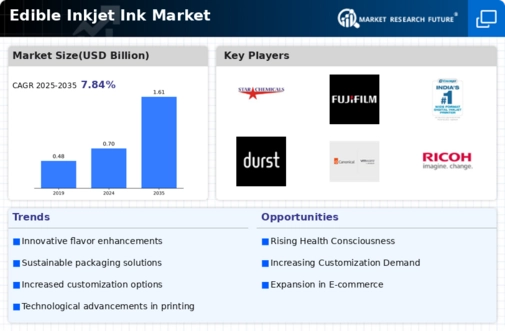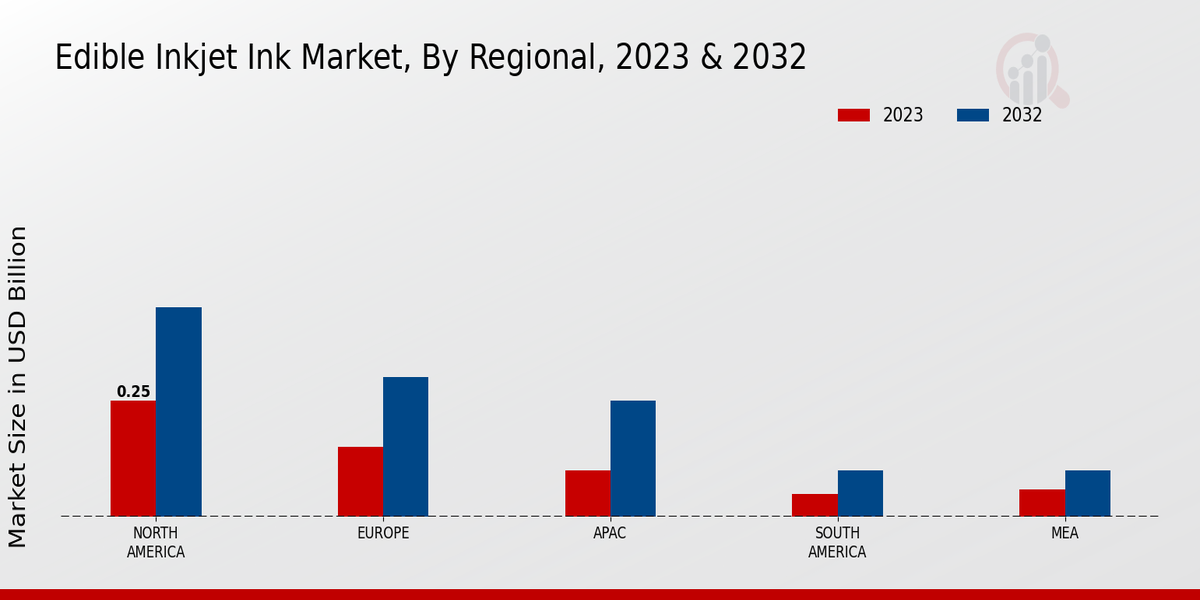Market Growth Projections
The Global Edible Inkjet Ink Market Industry is poised for substantial growth, with projections indicating a rise from 0.7 USD Billion in 2024 to 1.61 USD Billion by 2035. This growth trajectory suggests a compound annual growth rate (CAGR) of 7.85% from 2025 to 2035. Such figures highlight the increasing adoption of edible inkjet technology across various sectors, including bakeries, confectioneries, and catering services. The anticipated expansion reflects a broader trend towards customization and innovation in food presentation, positioning the edible inkjet ink market as a dynamic and evolving industry.
Expansion of the Food Industry
The Global Edible Inkjet Ink Market Industry benefits from the continuous expansion of the food and beverage sector. As the food industry diversifies, there is an increasing need for innovative packaging and decoration solutions. Edible inkjet inks provide a unique way to enhance product presentation and branding. This trend is particularly evident in the rise of artisanal and gourmet food products, where visual appeal is paramount. The market is projected to grow to 1.61 USD Billion by 2035, indicating a strong correlation between the food industry's growth and the demand for edible inkjet inks.
Rising Demand for Customization
The Global Edible Inkjet Ink Market Industry experiences a notable surge in demand for personalized food products. Consumers increasingly seek unique and customized edible prints for cakes, pastries, and other confections. This trend is driven by the growing popularity of social media, where visually appealing food items gain traction. As a result, businesses are investing in edible inkjet technology to cater to this demand. The market is projected to reach 0.7 USD Billion in 2024, reflecting a significant opportunity for manufacturers to innovate and expand their product offerings in this segment.
Regulatory Support for Food Safety
Regulatory frameworks that emphasize food safety and quality standards significantly impact the Global Edible Inkjet Ink Market Industry. Governments worldwide are implementing stringent regulations to ensure that food products, including those printed with edible inks, meet safety criteria. This regulatory support fosters consumer confidence and encourages manufacturers to invest in high-quality edible inks. Compliance with food safety regulations is likely to drive market growth, as businesses seek to align their products with these standards, thereby expanding their market reach and enhancing brand reputation.
Technological Advancements in Printing
Technological innovations play a crucial role in shaping the Global Edible Inkjet Ink Market Industry. Advancements in printing technology enhance the quality and efficiency of edible inkjet printing processes. Improved ink formulations and printer designs contribute to better color reproduction and durability of edible prints. These innovations not only attract more businesses to adopt edible inkjet technology but also expand the range of applications for edible inks. As the market evolves, the integration of cutting-edge technology is expected to drive growth and increase the overall market value.
Health Consciousness and Natural Ingredients
There is a growing awareness among consumers regarding health and wellness, which influences their purchasing decisions in the Global Edible Inkjet Ink Market Industry. Many consumers prefer products made from natural and organic ingredients, leading manufacturers to develop edible inks that align with these preferences. This shift towards healthier options is likely to drive growth in the market, as companies adapt their formulations to meet consumer demands. The anticipated growth rate of 7.85% CAGR from 2025 to 2035 indicates a robust market potential for edible inks that prioritize health-conscious ingredients.





















